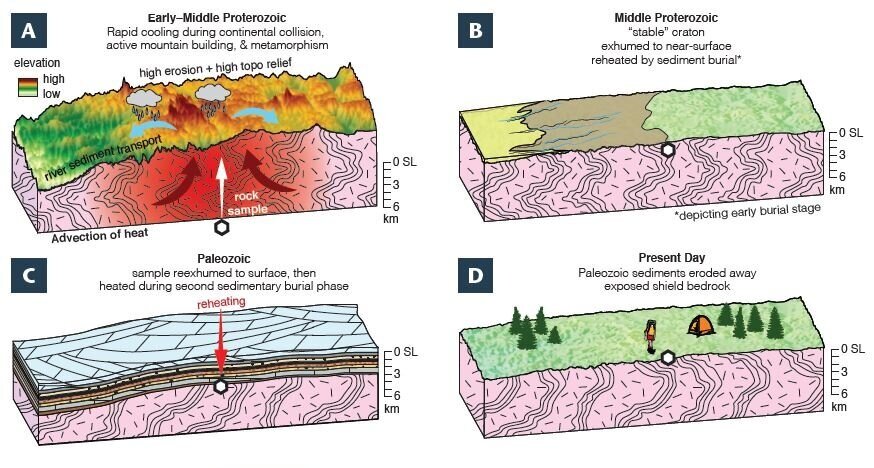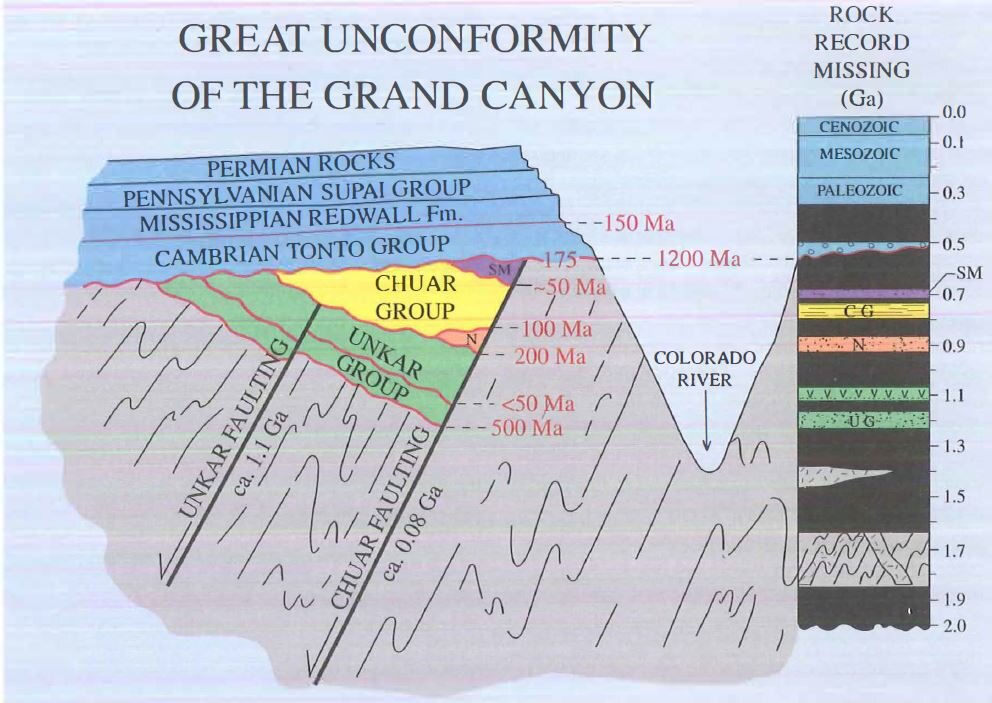Becky Flowers on Deciphering the Thermal History of Rocks
Becky Flowers is a Professor of Geological Sciences at the University of Colorado, Boulder. She uses the abundances of retained helium in minerals to determine the cooling history of the rocks containing these minerals. As she explains in the podcast, knowing the cooling history gives us a powerful tool for investigating erosion histories, enabling us to date when erosion surfaces were formed, even when the rocks overlying the erosion surface are absent from the geological record.
Courtesy of Christine Siddoway
Listen to the podcast here or wherever you listen to podcasts.
Scroll down for illustrations that support the podcast.
Note - playing the podcast is not supported on Internet Explorer; please use any other browser, or listen on Spotify, Apple Podcasts, etc.
Podcast Illustrations
All illustrations courtesy of Becky Flowers unless otherwise indicated.
Closure Temperature
Helium is continuously produced by radioactive decay of uranium and thorium, but at high temperatures the crystal acts as an open system, enabling the helium to diffuse out. At lower temperatures, the helium is “stuck” in the lattice, and the daughter-to-parent ratio increases linearly with accumulation time. The temperature at which the crystal transitions from open to closed behavior is called the closure temperature.
Metcalf and Flowers (2021), Encyclopedia of Geology, p. 69
Closure temperatures for a variety of minerals used in uranium-thorium-helium thermochronometry.
Ault et al. (2019), Tectonics, 38, 3705
In an erosional setting, apatite crystals approach the surface as erosion removes overlying material. The cooling associated with this exhumation process is revealed by uranium-thorium-helium thermochronology.
Ehlers & Farley (2003), Earth and Planetary Science Letters 206, 1
Apatite crystals selected for uranium-thorium-helium dating. The crystals are 50-100 microns long.
One instrument in Becky Flowers’s thermochronology lab. The rock samples are heated in the black heating chamber at top right, reaching a temperature above the closure temperature for helium in the mineral of interest, such as apatite. The released helium is directed via the cylindrical valves to the left of the heating chamber into a compact mass spectrometer located behind the control panels.
Southern Africa, Kimberlites, and Dynamic Topography
Relief map of southern Africa showing the high plateau studied by Becky Flowers and her team by using the kimberlite pipes within and on the margins of the plateau.
Stanley et al. (2015), G-cubed, 16, 3235
This map shows the locations of the kimberlite pipes studied by Becky Flowers and her team. The two study regions discussed in the podcast are indicated by the dashed rectangles. “Previous Work” rectangle marks the region in which the results showed a pronounced phase of erosion coincident with substantial lithospheric alteration and thinning, suggesting lithospheric processes contributed to elevation gain here. “Study Area” rectangle marks the region with a more protracted history of erosion and more subdued lithospheric alteration, suggesting that in this region the elevated topography was caused in part by another process, such as flow in the convecting mantle below the lithosphere, giving rise to dynamic topography.
Stanley et al. (2015), G-cubed, 16, 3235
Becky Flowers has measured the thermal history of rock samples from cratons that show multiple cycles of cooling and reheating. The diagrams show a geological history that could have caused such a history. (A) Early-middle Proterozoic: rapid cooling of the rock during a continental collision and the associated active mountain-building and metamorphism. (B) Middle Proterozoic: the rock sample was exhumed to near the surface. (C) Paleozoic: The sample is reheated by subsequent burial by sediments. (D) Present day: the overlying sediments are eroded away, causing cooling of the sample, and exposing the bedrock of the cratonic shield containing the rock sample. SL = sea level.
McDannell and Flowers (2020), Elements, 16, 325
The Great Unconformity
Barra Peak, a PhD student in Becky Flowers’s group, with her left hand resting on the Great Unconformity in the Grand Canyon. The beds below the Great Unconformity are dipping, while those above are generally flat-lying.
Stratigraphic column of the Grand Canyon Supergroup in the Upper Granite Gorge of the Grand Canyon. Unconformities are marked in red. The thermochronology studies of Becky Flowers and her team suggest that these unconformities are amalgamated into the single Great Unconformity in other locations. This indicates that the Great Unconformity developed in multiple phases corresponding to the amalgamation of Rodinia before 800 million years ago, the subsequent break-up of Rodinia, and Snowball Earth glaciations during the Cryogenian (717-645 million years ago).
In the western part of the Grand Canyon, the entire Grand Canyon Supergroup is absent, highlighting the heterogeneity on the local scale.
Peak et al. (2021), Geology, 49
Image from Karlstrom et al. (2012), GSA Special Paper, 489
Cross-section through the eastern Grand Canyon. Here, the three major sets of Grand Canyon rocks are: (1) upper horizontal layers of Paleozoic sedimentary strata (blue), (2) tilted sedimentary strata of the Grand Canyon Supergroup (green, yellow, orange, purple), and (3) metamorphic and igneous rocks of the Vishnu basement (grey). The red squiggly lines mark multiple unconformities that formed at different times during a several-hundred-million-year interval. In the time column at right, the time gaps across the unconformities are shown in black, with the estimated duration of each unconformity gap labeled in red within the figure. Although the Grand Canyon Supergroup is preserved in the eastern canyon, it is missing farther west. In the middle left of the cross-section where the Cambrian Tonto Group (blue) sits directly on the basement (grey), the Grand Canyon Supergroup is missing. Here, immediately adjacent to the preserved Grand Canyon Supergroup, Supergroup deposition and associated unconformity development (tilted red squiggly lines) probably occurred, but it is likely that the Supergroup sequence at this location eroded away to form a composite unconformity. Based on thermochronology work, Becky Flowers and her team infer that the Grand Canyon Supergroup was never deposited in the western Grand Canyon.
Conodonts are extinct vertebrates that resemble modern-day eels. Fossils of their tooth-like mouth parts occur widely in the geological record in shales and limestones, which are rocks that lack minerals, such as zircon and crystalline apatite that are amendable to uranium-thorium-helium thermochronometry. In order to obtain thermal histories of such sedimentary rocks, Becky Flowers attempted to apply the methods of thermochronometry to biologically produced apatite found within conodont fossils. The mobility of the parent uranium in conodont apatite makes this very challenging, but she has not given up on this.
Image from Zhang et al., (2017) Canadian Journal of Earth Sciences, 54, 936
Thermal History of the Moon
Since rocks undergo extreme heating during a meteor impact, thermochronology can be used to date the history of the meteor bombardment of the Moon. Becky Flowers and her group have dated the impact history of samples brought back to Earth by the Apollo missions.
Courtesy of NASA
Location from which the Apollo 14 sample was taken.
The Apollo 14 sample that Becky Flowers analyzed with uranium-thorium-helium thermochronology. Her results revealed that the rock had been subject to extreme heating 3.95 billion years ago and 110 million years ago.
Kelly et al. (2018), Earth & Planetary Science Letters, 482, 222
















